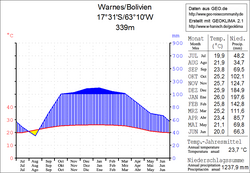Warnes (Santa Cruz)
| Warnes | ||
|---|---|---|
 Street in Warnes |
||
| Basic data | ||
| Residents (state) | 77,668 pop. (2012 census) | |
| rank | Rank 14 | |
| height | 339 m | |
| Post Code | 07-0201-0100-1001 | |
| Telephone code | +591 (3) 923- | |
| Coordinates | 17 ° 31 ′ S , 63 ° 10 ′ W | |
|
|
||
| politics | ||
| Department | Santa Cruz | |
| province | Ignacio Warnes Province | |
| climate | ||
 Climate diagram Warnes |
||
Warnes is a medium- sized town in the Santa Cruz department in the lowlands of the South American Andean state Bolivia . The city is named in honor of Colonel Ignacio Warnes (1772-1816), a military leader in the South American War of Independence.
Location in the vicinity
Warnes is the seat of the administration of the province Ignacio Warnes and the central place of the canton Warnes in the administrative district ( Bolivian : Municipio ) Warnes . The city is located at an altitude of 339 m on the right bank of the Río Piraí , 27 km above the mouth of the Río Guendá near Portachuelo .
geography
Warnes is located in the tropical, humid climate off the eastern edge of the Andes mountain range of the Cordillera Oriental . The region was covered by tropical rainforest before colonization , but is now largely cultivated land .
The mean average temperature of the region is just under 24 ° C (see Warnes climate diagram), the monthly values fluctuate between 20 ° C in June / July and 26 ° C from November to February. The annual precipitation is about 1300 mm, the monthly precipitation is productive and lies between 35 mm in August and 200 mm in January.
economy
A major industrial park ( Parque Industrial Latinoamericano ) is currently being built near Warnes , which is also to be connected to the railway network.
Transport network
Warnes is located 30 kilometers north of the capital Santa Cruz by road and 22 kilometers south of the city of Montero .
The 1,657-kilometer Ruta 4 highway , which crosses the country in a west-east direction, runs through Warnes from Tambo Quemado on the Chilean border to Puerto Suárez in the Brazil- Bolivia- Paraguay triangle . Coming from the west, the road leads via Cochabamba , Villa Tunari and Montero to Warnes , and then on via Santa Cruz and Roboré to Puerto Suárez and across the border to Corumbá, Brazil .
In the vicinity of the city, a road crosses the Río Piraí and leads to the nearby La Bélgica , a country town on the left, western side of the river.
population
The population of the place has increased threefold in the past two decades alone:
| year | Residents | source |
|---|---|---|
| 1976 | 4 419 | census |
| 1992 | 10 866 | census |
| 2001 | 17 872 | census |
| 2012 | 77 668 | census |
In the region, the Quechua are numerically the most important indigenous people , in the municipality of Warnes 13.5 percent of the inhabitants speak the Quechua language.
Individual evidence
- ↑ Thomas Brinkhoff: City Population
- ↑ Instituto Nacional de Estadística Bolivia (INE) 1992 ( Memento from April 23, 2014 in the Internet Archive )
- ^ INE - Instituto Nacional de Estadística Bolivia 2001 ( Memento of September 24, 2015 in the Internet Archive )
- ^ INE - Instituto Nacional de Estadística Bolivia 2012 ( Memento from March 4, 2016 in the Internet Archive )
- ↑ INE social data Santa Cruz 2001 ( Memento from September 25, 2013 in the Internet Archive ) (PDF; 5.2 MB)
Web links
- Relief map of the Santa Cruz region 1: 250,000 (PDF; 7.88 MB)
- Municipio Warnes - General Maps No. 70201
- Municipio Warnes - detailed map and population data (PDF; 678 kB) ( Spanish )
- Department Santa Cruz - Social data of the municipalities (PDF; 5.12 MB) ( Spanish )
